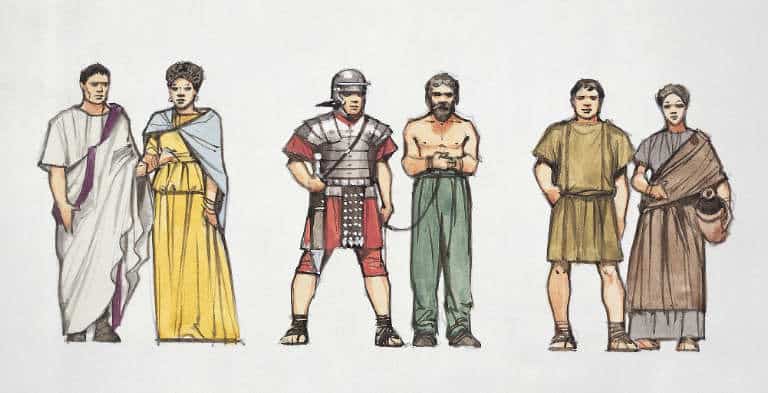When Rome established a republic in 509 B.C., two major classes developed. The patricians controlled the government with a Senate, made up of 300 elected officials. The senate chose two consuls to administer the laws of Rome. The only power that plebeians had in the government was with a popular assembly, which approved the choice of consuls.
Plebeians could not hold public office or marry into a patrician family. During the time of the Republic to the time of the empire, plebeians, who fought in many ways to help Rome gain power, demanded more rights. The government slowly began to change to appeal to plebeians who out-numbered everyone else in the population.
Around 494 B.C., an Assembly of Centuries and an Assembly of Tribes replaced the popular assembly. The Assembly of Centuries represented the Roman Army and all the classes that were included in it and they elected the consuls.
The Assembly of Tribes was made up of ten elected plebeians and spoke for the plebeians’ interests, but had little influence on the government. In 445 B.C, plebeians won the right to marry patricians. The Assembly of Tribes gained the right to pass laws and veto any government action that threatened the rights of the plebeians.
By about 300 B.C., plebeians had earned the right to hold all major political and religious posts. In 366 B.C., they won the right to the consulship. When Rome took over the control of an empire, the discrimination between the classes became indistinct. Julius Caesar was one of the many emperors that tried to bring the rich and poor closer to the poor by limiting the wealthy peoples’ land ownership.
During the early republic, the woman of Rome had few legal rights. A male was always responsible for the care and support of the family’s women. The question of women as heirs was irrelevant. Like all plebeians, even women patricians could not vote or hold public office. They were usually married off around the age of 14 to be housewives.
During the early republic, the woman of Rome had few legal rights. A male was always responsible for the care and support of the family’s women. The question of women as heirs were irrelevant. Like all plebeians, even women patricians could not vote or hold public office. They were usually married off around the age of 14 to be housewives.
Even though women didn’t have many rights, especially if their husbands or fathers held public office. Examples of these women would be Messalina (wife of emperor Claudius), Livia (second wife of Augustus), and Julia and Julia (daughter of Augustus and granddaughter of Augustus). During early Rome, the Merchants and artisans were included among the common people.
But, as the republic changed to an empire, it helped them out a lot. With the empire expanding and the need to spread the Roman culture, merchants and artisans became more important than ever.
The artisans spread the Roman culture by sending their many crafts and “masterpieces” to the newly conquered lands. The merchants, with all of this new land under Roman power, were free to trade along any route as Rome controlled most of them. Most of this rising of the merchants and artisans status happened during the Pax Romana. At the bottom of all of the classes were the slaves and non-citizens.
Neither of them had very many rights. Slaves were usually prisoners of war from countries that the Roman Empire had taken over. They were used as gladiators along with criminals (some freedmen did volunteer, though, for these “murderous Games” also). In addition, slaves were used as actors in early Roman plays and were owned by the managers who produced the plays. Some laws even specified that only slaves might be tortured. But later, freemen could also be tortured in cases of treason.
It was the right of the master to offer his slaves for torture in order to prove his own innocence or to discipline them. It was also his right to free any slaves that he owned if they showed their honor to him in a time of crisis, which he would have to prove. The right to torture slaves was not removed in Roman law until 240 A.D. Many non-citizens were also treated as if they were slaves.
They usually were from some land conquered by the Romans and were trying to make a better life in one of the cities. Intermarriages among the citizens and non-citizens of Rome were not allowed. Many non-citizens were also treated as if they were slaves.
They usually were from some land conquered by the Romans and were trying to make a better life in one of the cities. Intermarriages among the citizens and non-citizens of Rome were not allowed. The only way people were granted citizenship was if someone of high power gave it to them.
Soon the lands surrounding Rome under Roman Power were considered provinces of Rome, therefore the people that lived in them were right among the people of Rome through long and difficult processes, became closer to equality.
All of the social classes went through individual changes. Some, like the patricians, lost more in the end than what they started out with. Others, like non-citizens, gained more rights with laws that affected them. Overall, they each were affected by the government of the Roman Empire.
BIBLIOGRAPHY
1) World History, Patterns of Civilization. New Jersey: Burton F. Beers, 1993
2) Grolier Electronic Publishing, Inc., 1993
3) The World Book Encyclopedia Chicago, London, Sydney, Toronto, 1985


this has nothing about merchants.
What about the land lords?
Could women be merchants?
Can you please add more info on women during the Roman Republic?
what are plebeians and patricians?
Plebeians are people that are ordinary and poorer than the rich.
Patricians are rich people, people who thought they were special and plebeians were not.
no plebeians?